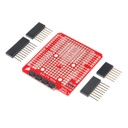Description: The SparkFun Qwiic Shield is an easy-to-assemble board that provides a simple way to incorporate the Qwiic Connect System with your Arduino-based device. This shield connects the I2C bus on your Arduino to a series of SparkFun Qwiic connectors and provides the circuitry to convert the 5V given to the 3.3V required by I2C boards in our Qwiic system. As long as your devices are on different addresses, the Qwiic system allows for daisy chaining, meaning you can stack as many sensors as you’d like to create a tower of sensing power!
The Qwiic Shield has four Qwiic connection ports, all on the same I2C bus, as well as a large prototyping area to design and make your own unique circuits. The shield also has a few 3-by-1 rails to help with prototyping, as well as buses for ground, 5V and even 3.3V. We have included four mounting ports in the same design as our Qwiic sensors, allowing you to affix your small board to the top of the shield.
The SparkFun Qwiic Connect System is an ecosystem of I2C sensors, actuators, shields and cables that make prototyping faster and less prone to error. All Qwiic-enabled boards use a common 1mm pitch, 4-pin JST connector. This reduces the amount of required PCB space, and polarized connections mean you can’t hook it up wrong.
Note: This includes R3 Arduino headers, but they are not pre-soldered onto the board, so some assembly will be required when putting the shield together.
Features:
- 4x Qwiic Connection Ports
- Large Prototyping Area
- 3-by-1 Prototyping Rails
Includes:
- 1x SparkFun Qwiic Shield for Arduino
- 1x Arduino Stackable Header Kit – R3
Documentation and Downloads









